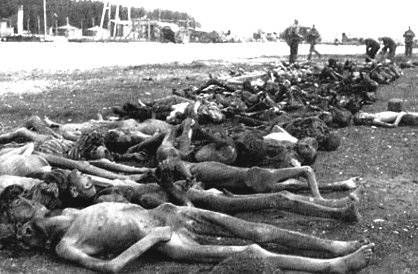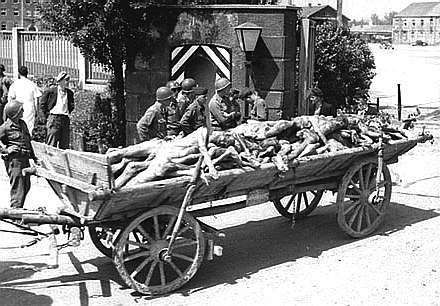|
Nazi Germany maintained concentration camps (in German Konzentrationslager, or KZ) throughout the territories it controlled. The first Nazi concentration camps set up in
Germany were greatly expanded after the Reichstag fire of 1933, and were intended to hold political prisoners and opponents of the regime. The term was borrowed from the
British concentration camps of the Second Anglo-Boer War.
The number of camps quadrupled between 1939 and 1942 to 300+, as slave-laborers from across
Europe, Jews, political prisoners, criminals, homosexuals, gypsies, the mentally ill and others were
incarcerated, generally without judicial process. Holocaust scholars draw a distinction between concentration camps (described in this article) and extermination camps, which were established by the Nazis for the industrial-scale mass murder of the predominantly Jewish ghetto and concentration camp populations.

Human
corpses from Landsberg concentration camp
Pre-war camps
The Dachau camp was created for holding political opponents. In time for Christmas 1933 roughly 600 of the inmates were released as part of a pardoning action. The picture above depicts a speech by camp commander Theodor Eicke to prisoners about to be released.
Inspection by the Nazi party and Himmler at the Dachau Protective Custody Camp on 8 May 1936.Use of the word "concentration" came from the idea of using documents confining to one place a group of people who are in some way undesirable. The term itself originated in the
"reconcentration camps" set up in Cuba by General Valeriano Weyler in 1897. Concentration camps had in the past been used by the U.S. against Native Americans (or American Indians), by the British in the Boer wars, and wherever the "undesirables" had to be kept in check by those who incarcerated them.
When the Nazis came to power in Germany, they quickly moved to ruthlessly suppress all real or potential opposition. The general public was intimidated through arbitrary psychological terror. Between 1933 and 1945, the special courts
(Sondergerichte) set up by the Nazi regime executed 12,000 German
nationals. Especially during the first years of their existence these courts "had a strong deterrent effect" against any form of political
protest.
The first camp in Germany, Dachau, was founded in March 1933. The press announcement said that "the first concentration camp is to be opened in Dachau with an accommodation for 5,000 persons. All Communists and – where necessary – Reichsbanner and Social Democratic functionaries who endanger state security are to be concentrated there, as in the long run it is not possible to keep individual functionaries in the state prisons without overburdening these
prisons." Dachau was the first regular concentration camp established by the German coalition government of National Socialist Workers' Party (Nazi Party) and the Nationalist People's Party (dissolved on 6 July 1933). Heinrich
Himmler, then Chief of Police of Munich, officially described the camp as "the first concentration camp for political
prisoners."
Dachau served as a prototype and model for the other Nazi concentration camps. Almost every community in Germany had members taken there. The newspapers continuously reported of "the removal of the enemies of the Reich to concentration camps" making the general population more aware of their presence. There were jingles warning as early as 1935: Dear God, make me dumb, that I may not to Dachau
come.
Between 1933 and the fall of Nazi Germany in 1945, more than 3.5 million Germans were forced to spend time in concentration camps and prisons for political
reasons and approximately 77,000 Germans were executed for one or another form of resistance by Special Courts, courts-martial, and the civil justice system. Many of these Germans had served in government, the military, or in civil positions, which enabled them to engage in subversion and conspiracy against the
Nazis.
As a result of the Holocaust, the term "concentration camp" carries many of the connotations of "extermination camp" and is sometimes used synonymously. Because of these ominous connotations, the term "concentration camp", originally itself a euphemism, has been replaced by newer terms such as internment camp, resettlement camp, detention facility, etc., regardless of the actual circumstances of the camp, which can vary a great deal.
Concentration
Camps - Youtube
World War II
Jewish prisoners are issued food on a building site at Salaspils concentration camp in 1941.After September 1939, with the beginning of the Second World War, concentration camps became places where millions of ordinary people were enslaved as part of the war effort, often starved, tortured and
killed. During the War, new Nazi concentration camps for "undesirables" spread throughout the continent. According to statistics by the German Ministry of Justice, about 1,200 camps and subcamps were run in countries occupied by Nazi
Germany, while the Jewish Virtual Library estimates that the number of Nazi camps was closer to 15,000 in all of occupied
Europe and that many of these camps were created for a limited time before being
demolished Camps were being created near the centers of dense populations, often focusing on areas with large communities of Jews, Polish intelligentsia, Communists or Roma. Since millions of Jews lived in pre-war
Poland, most camps were located in the area of General Government in occupied Poland, for logistical reasons. The location also allowed the Nazis to quickly remove the German Jews from within Germany proper. In 1942, the SS built a network of Extermination camps to systematically kill millions of prisoners by gassing. The extermination camps (Vernichtungslager) and death camps (Todeslager) were camps whose primary function was genocide. The Nazis themselves distinguished between concentration camps and the extermination
camps. The British intelligence service had information about the concentration camps, and in 1942 Jan Karski delivered a thorough eyewitness account to the government.
Internees
The two largest groups containing prisoners in the camps, both numbering in the millions, were the Polish Jews and the Soviet prisoners of war (POWs) held without trial or judicial process. Large numbers of Roma (or Gypsies), ethnic
Poles, political prisoners, homosexuals, people with disabilities, Jehovah's Witnesses, Catholic clergy, Eastern European intellectuals and others (including common criminals, as declared by the Nazis). In addition, a small number of Western Allied aviators were sent to concentration camps as
spies. Western Allied POWs who were Jews, or whom the Nazis believed to be Jewish, were usually sent to ordinary POW camps; however, a small number were sent to concentration camps under antisemitic
policies.
A mass grave inside Bergen-Belsen concentration camp.Sometimes the concentration camps were used to hold important prisoners, such as the generals involved in the attempted assassination of Hitler; U-boat Captain-turned-Lutheran pastor Martin
Niemöller; and Admiral Wilhelm Canaris, who was interned at Flossenbürg on February 7, 1945, until he was hanged on April 9, shortly before the war’s end.
In most camps, prisoners were forced to wear identifying overalls with colored badges according to their categorization: red triangles for Communists and other political prisoners, green triangles for common criminals, pink for
homosexual men, purple for Jehovah's Witnesses, black for Gypsies and
asocials, and yellow for
Jews.

President
Bush - is he a Human Rights hypocrite?
Dual
standards, it's not okay if they do it, but it's okay for us.
Treatment
Starving prisoners in Mauthausen concentration camp liberated on May 5, 1945.
A concentration camp victim identifies an SS guard in June 1945.Many of the prisoners died in the concentration camps through deliberate maltreatment, disease, starvation, and overwork, or were executed as unfit for labor. Prisoners were transported in inhumane conditions by rail freight cars, in which many died before reaching their destination. The prisoners were confined to the boxcars for days or even weeks, with little or no
food or water. Many died of dehydration in the intense heat of summer or froze to death in winter. Concentration camps also existed in Germany itself, and while they were not specifically designed for systematic extermination, many of their inmates perished because of harsh conditions or were executed.
In the early spring of 1941, the SS – along with doctors and officials of the T-4 Euthanasia Program – introduced the Action 14f13 programme meant for extermination of selected concentration camp
prisoners. The Inspectorate of the Concentration Camps categorized all files dealing with the death of prisoners as 14f, and those of prisoners sent to the T-4 gas chambers as 14f13. Under the language regulations of the SS, selected prisoners were designated for "special treatment (German:
Sonderbehandlung) 14f13". Prisoners were officially selected based on their medical condition; namely, those permanently unfit for labor due to illness. Unofficially, racial and eugenic criteria were used: Jews, the handicapped, and those with criminal or antisocial records were
selected.
For Jewish prisoners there was not even the pretense of a medical examination: the arrest record was listed as a physician’s
“diagnosis”. In early 1943, as the need for labor increased and the gas chambers at Auschwitz became operational, Heinrich Himmler ordered the end of Action
14f13.
After 1942, many small subcamps were set up near factories to provide forced labor. IG Farben established a synthetic
rubber plant in 1942 at Monowitz concentration camp (Auschwitz III); other camps were set up next to airplane factories, coal mines and rocket propellant plants. Conditions were brutal and prisoners were often sent to the gas chambers or killed if they did not work quickly enough.
After much consideration, the extermination of the Jewish prisoners (the “Final Solution”) was announced to high ranking officials at the Wannsee Conference in
1942.
Towards the end of the war, the camps became sites for medical experiments.
Eugenics experiments, freezing prisoners to determine how downed pilots were affected by exposure, and experimental and lethal medicines were all tried at various camps. Female prisoners were routinely
raped and degraded in the
camps.
Concentration
Camps - Youtube
Liberation
The camps were liberated by the Allied and
Soviet forces between 1944 and 1945. The first major camp, Majdanek, was discovered by the advancing Soviets on July 23, 1944. Auschwitz was liberated, also by the Soviets, on January 27, 1945; Buchenwald by the Americans on April 11; Bergen-Belsen by the British on April 15; Dachau by the Americans on April 29; Ravensbrück by the Soviets on the same day; Mauthausen by the Americans on May 5; and Theresienstadt by the Soviets on May
8. Treblinka, Sobibor, and Bełżec were never liberated, but were destroyed by the Nazis in 1943. Colonel William W. Quinn of the U.S. 7th Army said of Dachau: "There our troops found sights, sounds, and stenches horrible beyond belief, cruelties so enormous as to be incomprehensible to the normal
mind."
In most of the camps discovered by the Soviets, almost all the prisoners had already been removed, leaving only a few thousand alive—7,000 inmates were found in Auschwitz, including 180 children who had been experimented on by
doctors. Some 60,000 prisoners were discovered at Bergen-Belsen by the British 11th Armoured
Division, 13,000 corpses lay unburied, and another 10,000 died from typhus or malnutrition over the following
weeks. The British forced the remaining SS guards to gather up the corpses and place them in mass
graves.

Types of camps
Commander-in-Chief of all Allied Forces, General Dwight D. Eisenhower witnesses the corpses found at Ohrdruf forced labor camp in May 1945.According to Moshe
Lifshitz, the Nazi camps divided as follows:
-
Hostage camps: camps where hostages were held and killed as reprisals.
-
Labor camps: concentration camps where interned inmates had to do hard physical labor under inhumane conditions and cruel treatment. Some of these camps were sub-camps of bigger camps, or "operational camps", established for a temporary need.
-
POW camps: concentration camps where prisoners of war were held after capture. POWs were usually soon assigned to labor camps.
-
Camps for rehabilitation and re-education of Poles: camps where the intelligentsia of the ethnic Poles were held, and "re-educated" according to Nazi values as slaves.
-
Transit and collection camps: camps where inmates were collected and routed to main camps, or temporarily held (Durchgangslager or
Dulag).
-
Extermination camps: These camps differed from the rest, since not all of them were also concentration camps. Although none of the categories is independent, and many camps could be classified as a mixture of several of the above, and all camps had some of the elements of an extermination camp, systematic extermination of new-arrivals occurred in very specific camps. Of these, four were extermination camps, where all new-arrivals were simply killed – the "Aktion Reinhard" camps (Treblinka, Sobibor and Belzec), together with Chelmno. Two others (Auschwitz and Majdanek) were combined concentration and extermination camps. Others like Maly Trostenets were at times classified as "minor extermination
camps".
Post-war use
Though most Nazi concentration and extermination camps were destroyed after the war, some were made into permanent memorials. In Communist Poland, some camps such as Majdanek, Jaworzno, Potulice and Zgoda were used to hold German prisoners of war, suspected Nazis and collaborators, anti-Communists and other political prisoners, as well as civilian members of the German, Silesian and
Ukrainian ethnic minorities. Currently, there are memorials to both camps in Potulice; they have helped to enable a German-Polish discussion on historical perception of
World War II. In East Germany (Buchenwald and Sachsenhausen), concentration and extermination camps were used for similar purposes. Dachau concentration camp was used as a prison for arrested Nazis.
Concentration
Camps - Experiments, Youtube
GENERAL
HISTORY
|
John
Storm and the
Cyber Wars
In
1945 Adolf Hitler refuses to accept defeat in the face of the
advancing allied forces. He's tried the V1 flying bomb and V2
rocket, but failed to deliver a nuclear
strike. He may have lost this battle, but he has a plan up his
sleeve for world supremacy that the allies could not possibly
foresee.
Over
70 years will pass before Hitler's
terrible scheme begins to see results.

This
modern adventure story by Jameson Hunter
|
LINKS:
Adolf
Hitler
Cloning
Concentration
Camps
Eugenics
Human
Genome Project
Lebensborn
The
4th Reich
MARITIME
HISTORY
|


